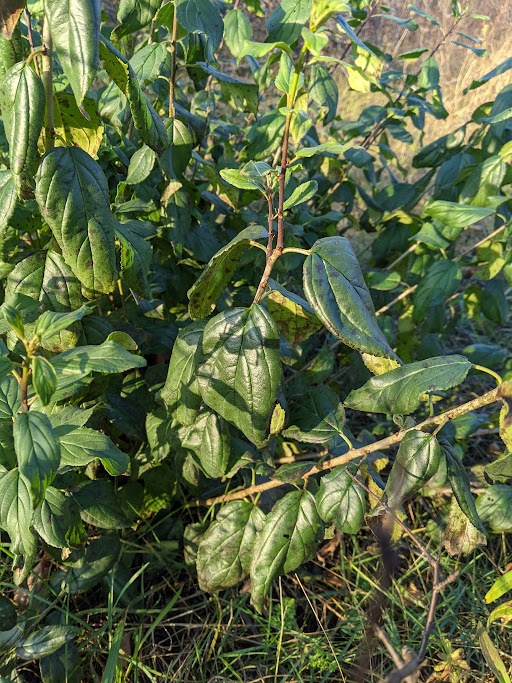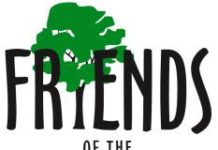by Fred Schueler and Aleta Karstad
Fragile Inheritance Natural History
As the leaves of native trees and shrubs fall, the last broad-leaved green along roads and in the oldfields of eastern Ontario is Rhamnus cathartica. This invasive shrub or tree is called European, Purging, or Common Buckthorn, though we call it “Cathartic,” in accordance with the policy of having frightening-sounding English names for invasive species.

This is a dark-barked semi-shade tolerant small-leaved shrub, with lenticel-barred twigs often sharpened into thorns. The leaves are dark green, and are shed late in the fall, forming billows of green under the Emerald Ash Borer-killed Ashes which now make up so much of our woods. It is a species which acts out all the elements of invasiveness: it leafs out early in the spring, and retains its leaves into November, it produces toxins which inhibit the growth of other plants and poison tadpoles in adjacent ponds, it can grow up into a tree (we found one 25 cm in diameter near an old Loyalist homesite near Domville), or twist up into the canopies of Sugar Maples or Apples like a vine (we recently cut one that was 3 cm in diameter and 478 cm tall), and it effectively has no insect pests.
The cathartic character means that the black berries, which are held on the plant into the winter, pass rapidly through birds which eat them to be purple spots on snow or sidewalks, while blue spots on the snow mean that Deer or Rabbits have been browsing on this species, because when they’ve eaten it, their urine turns blue after exposure to sunlight. Goats are quite fond of the twigs and foliage, and feeding the goats was for a long while our major mode of control of the Buckthorn on our land.
As with Frangulous Buckthorn, control has to be a sport, rather than a project, and a sport that is very like combat. When we were first battling with the Cathartics, Fred wasn’t wielding the axe carefully enough, and the thorns twice scratched the cornea of his eye, a notably painful experience. When the stems are cut, they often stay tangled in the canopy – we recently felled a low 25 cm diameter tree, and each of the branches was so tangled overhead that none of them fell when cut.
Once cut, the stumps sprout prolifically, often going up more than a metre in a year, with a splay of horizontal shoots along the ground, and when the canopy is opened there can be a veritable sod of seedlings growing from the previous fall of berries. The more specialized methods of control are weed wrench tools, which can uproot stems up to 5 cms in diameter, while for larger trees some organizations have used tractors for uprooting. Girdling can weaken larger shrubs, daubs of herbicide can be used to kill stumps, and there’s a new treatment based on a native fungus, Chondrostereum purpureum, that kills the stumps. A few colonies of the Eastern Tent Caterpillar, Malacosoma americanum, are found on Cathartic Buckthorns every year, and next year we’re going to move such of these colonies as we find to Buckthorns on our land, to see if the genes which give the caterpillars a taste for the invader can be concentrated into a population that may give some control.
With the Emerald Ash borer deaths of so many of our Ash trees, the invasion of the Buckthorns has become the biggest environmental change in eastern Ontario. Cathartic Buckthorn is listed as a provincially noxious weed in the Weed Control Act. and the struggle against them will be facilitated if more hands and axes are raised in opposition.






On 08-Mar.-22 5:12 p.m., Derrick Hopkins wrote:
> I’ve finally “gone live” with the Blue Rabbit Pee video on YouTube. You can watch it here: https://www.youtube.com/watch?v=fwm-5tFAM1I